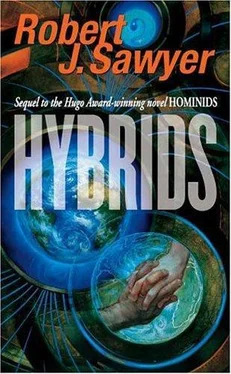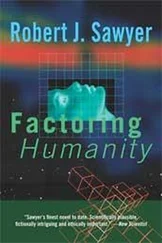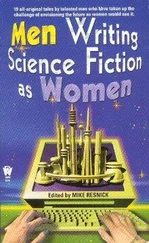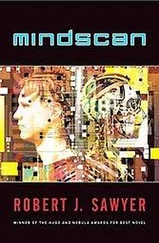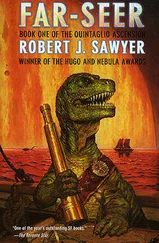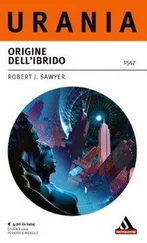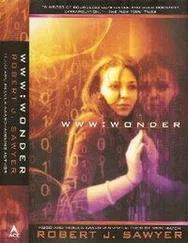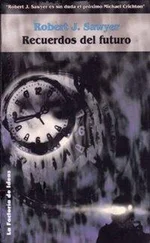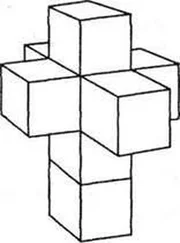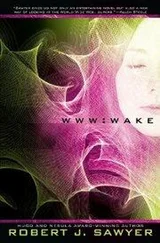Robert Sawyer - Hybrids
Здесь есть возможность читать онлайн «Robert Sawyer - Hybrids» весь текст электронной книги совершенно бесплатно (целиком полную версию без сокращений). В некоторых случаях можно слушать аудио, скачать через торрент в формате fb2 и присутствует краткое содержание. Жанр: Фантастика и фэнтези, на английском языке. Описание произведения, (предисловие) а так же отзывы посетителей доступны на портале библиотеки ЛибКат.
- Название:Hybrids
- Автор:
- Жанр:
- Год:неизвестен
- ISBN:нет данных
- Рейтинг книги:4 / 5. Голосов: 1
-
Избранное:Добавить в избранное
- Отзывы:
-
Ваша оценка:
- 80
- 1
- 2
- 3
- 4
- 5
Hybrids: краткое содержание, описание и аннотация
Предлагаем к чтению аннотацию, описание, краткое содержание или предисловие (зависит от того, что написал сам автор книги «Hybrids»). Если вы не нашли необходимую информацию о книге — напишите в комментариях, мы постараемся отыскать её.
Hybrids — читать онлайн бесплатно полную книгу (весь текст) целиком
Ниже представлен текст книги, разбитый по страницам. Система сохранения места последней прочитанной страницы, позволяет с удобством читать онлайн бесплатно книгу «Hybrids», без необходимости каждый раз заново искать на чём Вы остановились. Поставьте закладку, и сможете в любой момент перейти на страницу, на которой закончили чтение.
Интервал:
Закладка:
Chapter Twenty-three
“ But the Neanderthals didn’t cross the Strait of Gibraltar. There, at Gibraltar, we saw the difference between us and them. For, when we saw a new world, just a short distance away, we took it…”
“This,” said Vissan, placing a pale green device on the table in her cabin, “is the prototype codon writer.”
Mary looked at the machine. It was about the size and shape of three loaves of bread, placed end to end-although no Neanderthal would ever think of it that way.
“It can synthesize any string of deoxyribonucleic acid, or ribonucleic acid, if you prefer, as well as the additional proteins needed to manufacture chromosomes or other structures.”
Mary shook her head in wonder. “It’s a life factory.” She looked at Vissan. “In my world, you would have won the Nobel Prize for this-our top honor for scientific work.”
“But here,” said Vissan, “it is banned.” Her voice was bitter. “My intentions were so benign.”
Mary frowned. “What were your intentions?”
Vissan was quiet for a moment. “I have a younger brother who lives in an institution.” She looked at Mary. “We have eliminated most inheritable genetic disorders, but there are still things that can go wrong, things that are genetic but not inherited. My brother has-I don’t know what you call it. He has an extra chromosome twenty-two.”
“Chromosome twenty-one, you mean,” said Mary. Then: “No, of course you don’t. It would be number twenty-two here. We call that Down syndrome.”
“Are the symptoms the same in Gliksins?” asked Vissan. “Mental and physical feebleness?”
Mary nodded. But Down also caused facial abnormalities in Gliksins, including a protruding tongue, a slack jaw, and epicanthic folds even in occidentals. Mary wondered what a Barast with Down syndrome would look like.
“My mother was a member of generation 140. She should have had her first child when she was twenty years old, but failed to conceive then-or when she was thirty. She had me when she was forty, and my brother Lanamar when she was fifty.”
“Conceptions that late in life increase the likelihood of Down in my people, too,” said Mary.
“Because the body’s ability to produce clean sets of chromosomes has deteriorated. I wanted to overcome that-and I did. My codon writer could have eliminated all copying errors, all-”
“All what?” said Mary.
“I’m sorry,” said Christine. “I don’t know how to translate the word Vissan has used. It refers to when there are three chromosomes where there should only be a pair.”
“Trisomy,” supplied Mary.
“Had my parents had access to such technology,” continued Vissan, “letting them output a perfect diploid set of chromosomes despite their age, Lanamar would be normal. And, of course, there are a host of similar conditions that also could be avoided.”
Indeed there are, thought Mary. One in 500 Gliksin children were born with a sex-chromosome difficulty, such as Klinefelter syndrome (two or more X chromosomes and a Y, or often a mosaic), triple-X syndrome, Turner syndrome (a single X chromosome either completely lacking a mate or with a truncated second sex chromosome), or XYY syndrome, which could predispose males to violence-she suspected Cornelius Ruskin had an extra Y; he certainly had the body type and personality. Other combinations occurred, but they mostly resulted in miscarriages.
“But that’s not all,” said Vissan. “Preventing trisomy and similar disorders was only the initial impetus for my work. Once I got into my research, other wondrous possibilities occurred to me.”
“Yes?” said Ponter.
“Yes, indeed! I wanted to eliminate the randomness in gene selection, leaving the choices of traits up to the parents.”
“How do you mean?” asked Ponter.
Vissan looked at him. “You inherited a bunch of traits from your father and another bunch from your mother; half of your deoxyribonucleic acid came from each of them, and in total, those two halves make up your forty-eight chromosomes. But each sperm you produce has a random selection of all those traits. You-Ponter Boddit-have DNA that contains both your father’s contribution to your eye color and your mother’s, plus your father’s contribution to your hair color and your mother’s, your father’s contribution to your browridge shape and your mother’s, and so on. But your sperm contain only twenty-four chromosomes, with just half your deoxyribonucleic acid. Any given sperm you make will contain either your father’s contribution to a given trait or your mother’s, but not both. One sperm might contain your mother’s contribution to eye color, your father’s to hair color, and your mother’s to browridge shape. Another might have exactly the opposite combination. A third might contain only your mother’s contributions to those things. A fourth, only your father’s. And so on, for all the tens of thousands of different genes you possess. No two sperm you ever produced will likely have the same combination of traits coded into it. The same sort of thing happens in the production of eggs, and, again, it’s a virtual certainty that no two eggs share the same combination of the mother’s mother’s genetic material and the mother’s father’s genetic material.”
“All right,” said Ponter.
“In fact-Mega here is your daughter, right?”
“Yes, I am!” said Mega.
Vissan crouched down to be at Mega’s face height. “Now, she has brown eyes, whereas you have golden ones,” said Vissan. “Do you have any other children?”
“An older daughter, named Jasmel.”
“And what color are Jasmel’s eyes?”
“The same as mine.”
“She’s so lucky!” said Mega, pouting.
“Indeed she is,” said Vissan, rising and patting the girl on her head. She looked at Ponter. “Brown is dominant; golden is recessive. The chances of a child of yours inheriting your eye color through natural processes were one in four. But if you’d let the codon writer output your genetic material for you, you could have chosen to give both your children golden eyes-or any other trait you or your woman-mate carried the genetic code for.”
“Aww,” said Mega. “I wish I had golden eyes!”
“Understand?” said Vissan. “What happens in a natural conception is that a set of traits selected entirely at random ends up being combined together.”
Ponter nodded.
“But don’t you see?” said Vissan. “That’s a crazy way to do it! An absolute gamble as to what you are going to get. And it doesn’t have to be related to things as inconsequential as eye color. You possess two genes related to the flexibility of the lens in your eye: one from your mother, and one from your father. Say the one you got from your mother is a good one that lets you see without corrective eyewear well into old age, but the one you got from your father is a bad one that would require you to use corrective eyewear from childhood. You will pass one, and only one, of those two on to your own offspring. Which would you choose?”
“My mother’s one, of course,” said Ponter.
“Exactly! But, in natural conception, there is no choice-no choice at all. It’s pure luck of the draw which one your child will get…because you let inefficient nature produce your sperm. But if we sequenced your deoxyribonucleic acid, we could choose the better one of each pair of traits you yourself had inherited, and then we could manufacture a haploid set of chromosomes containing only those better traits. We could also do the same thing with Mary, here, producing a haploid set representing only the better traits from her repertoire. And then we could combine them together to produce the best child you could possibly have. The child would still absolutely be one-half its father genetically and one-half its mother, but it would have the best possible combination of their respective genetic material.”
Читать дальшеИнтервал:
Закладка:
Похожие книги на «Hybrids»
Представляем Вашему вниманию похожие книги на «Hybrids» списком для выбора. Мы отобрали схожую по названию и смыслу литературу в надежде предоставить читателям больше вариантов отыскать новые, интересные, ещё непрочитанные произведения.
Обсуждение, отзывы о книге «Hybrids» и просто собственные мнения читателей. Оставьте ваши комментарии, напишите, что Вы думаете о произведении, его смысле или главных героях. Укажите что конкретно понравилось, а что нет, и почему Вы так считаете.
